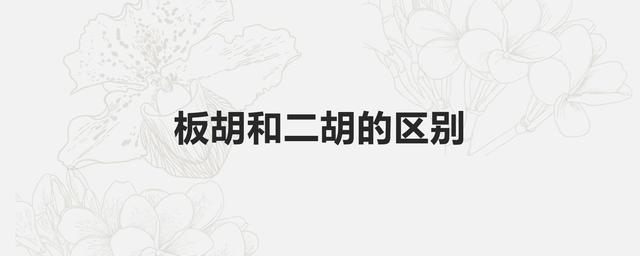What is the difference between Banhu and Erhu?
6635 views · Organized by 愛 on 2022-03-16
Erhu originated in the Tang Taizu period and has been recorded for thousands of years. It was originally a characteristic musical instrument of local ethnic groups, and later it was introduced to the central government and spread. Banhu has a history of more than 300 years in China, and its name is derived from the fact that the qin barrel is made of thin wooden boards. What are the specific differences between them? Let's take a look together.

The differences between banhu and erhu are as follows:
1. The barrels of the erhu are mostly made of relatively expensive woods, which have good toughness and high firmness. In addition, they also use more regular patterns for the decoration of the body. The banhu piano generally adopts a relatively smooth shape, mostly coconut shells;
2. The brackets are different. The bracket of the erhu is mainly used to control the strings, and the materials come from a wide range. The brackets of banhu are mostly made of precious wood;
3. How to use, the erhu has a high degree of timbre coordination and strong adaptability, and is suitable for a variety of performance styles, but it is used for ensembles, while the timbre of the banhu is sharper and can only play a leading role.
Involving musical instruments
Banhu (pinyin: bǎn hú) is a kind of stringed instrument with a history of more than 300 years in China. The timbre is high, firm, and has strong penetrating power. It is the main accompaniment instrument for northern opera and rap.
Erhu (Pinyin: Erhu) originated in the Tang Dynasty, called "Xiqin", and has a history of more than a thousand years. It is a traditional Chinese stringed instrument. Erhu, or Erxian Huqin, also known as "Nanhu" and "Omzi", is one of the main bowed and stringed instruments (wiping strings) in the Chinese national musical instrument family.
Guess you like
Organized by 南丘 on 2022-05-26
Kneading, pressing, sliding, and restraint, pressing, rolling, and panning, pressing and kneading, rolling and rolling, and sliding.
read >>
Organized by 蕾伊 on 2022-05-09
As the saying goes, a year of flute and two years, and Hu Xian did not listen to three years. It is not difficult to see that learning erhu or board is simple, but it is not a matter of overnight learning. After the kung fu, the kung fu is naturally achieved.
read >>
Organized by 九曲 on 2022-05-07
The method for determining the height of the Henan Opera Banhu is the same as that of the Erhu. Once the weight is determined, there is no need to adjust it if there is no special need in use.
read >>
Organized by 愛 on 2022-05-07
Banhu, a kind of stringed instrument, has a history of more than 300 years in China, and has various names, such as Qinhu, Huhu, Bangzihu, Daxian, etc. The timbre is high, firm, and has strong penetrating power. It is the main accompaniment instrument for northern opera and rap, and can also be used for ensemble and solo.
read >>
Organized by 迷雾风暴 on 2022-05-07
Banhus vary from region to region and have different tunings. Banhu is divided into high and low. Among them, there are fourths and fifths. Generally, pure fifths are more suitable for bands.
read >>

 渝公网安备 50010702504639号
渝公网安备 50010702504639号